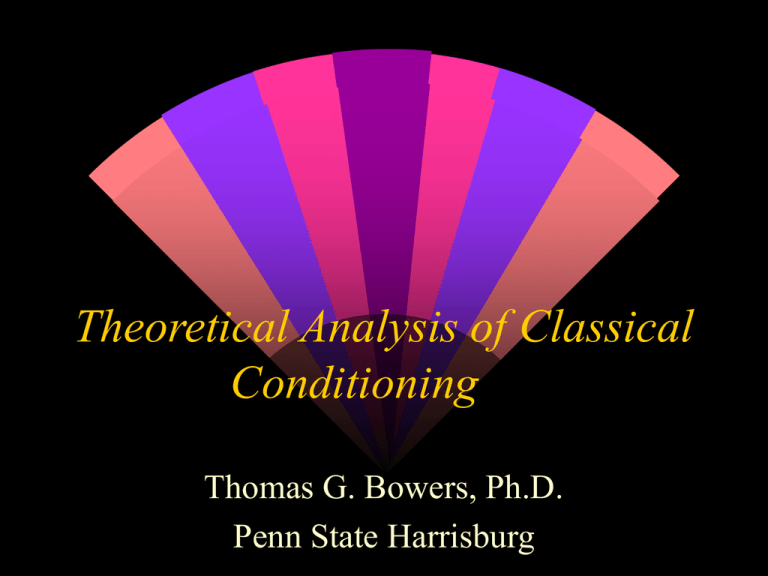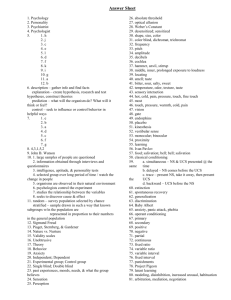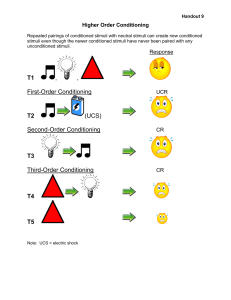Theories of Classical Conditioning
advertisement

Theoretical Analysis of Classical Conditioning Thomas G. Bowers, Ph.D. Penn State Harrisburg Adaptive Function of CR What adaptive contributions have been made by an organisms ability to demonstrate classical conditioning? Organisms not only learn CS-UCS relationships, they appear to be adaptive for the organism The relationships are often of biological significance CR That Oppose UCR Well trained animals demonstrate an antagonistic CR to some aversive stimulation Examples include the conditioned development of tolerance Tolerance is a biological adaptation, the adjustment of the body to maintain homeostatic tone CR That Oppose UCS For example, biological adjustment to regular doses of most drugs or medications Adaptation to the use of alcohol or morphine, or any other psychoactive substance More recently, we have now considered the role of classical conditioning in the development of tolerance CR That Oppose UCS Opponent process theory developed to explain patterns of conditioning Solomon & Corbit, 1974 Hedonic or emotional stimulus also produces a later effect opposite of the initial process Referred to as process “a” or process “b” CR That Oppose UCS Opponent process theory developed to explain patterns of conditioning “A” process develops early, but “B” processes begin to occur earlier over time These processes summate to attenuate the overall response Opponent Process Theory a Early trials b a b Later trials Opponent Process Theory Early trials Later trials Habituation Reduction of responding after many stimulation trials Can be understood by opponent process models What Is Learned in Conditioning? CS UCS S-R Learning UCR CR UCS S-S Learning UCR Some Processes CS2 Buzzer CS1 Light Sensory Preconditioning Phase One CS1 Light Sensory Preconditioning Phase Two UCS Food Some Processes CS2 Buzzer Test to CS 2 Yields CR These results indicate CR occurs to CS2, implying S-S learning Some Processes CS1 Light UCS Food CS1 CS2 Buzzer Second Order Conditioning Some Processes CS2 Conditioning occurs here, and may seem to be due to S-R learning, but S-S explanations are also possible Test to CS 2 Buzzer Explanations of Classical Conditioning Mere CS-UCS pairing is not enough There is also required to be a contingency Example of the informative nature of weather reports Significance of Contingency Fear and anxiety results from aversive circumstances Anxiety is more reflective on noncontingent or difficult to predict circumstances Fear may be more stimulus bound Conditioning Can Be Selective Kamin demonstrated blocking effects of one of a set of compound stimuli One stimulus provides redundant information Conditioned inhibition can develop if the second stimulus signals safety Rescorla Wagner Theory Describes negatively accelerated learning curve Vn = K( - V n-1) Where V is associative strength, is the change in response strength, is the asymptote of conditioning. K reflects salience of the CS-UCS Rescorla - Wagner Theory V3 V2 V1 Rescorla - Wagner Theory Theory predicts redundant stimuli become inhibitory, which is also demonstrated experimentally On the other hand, the theory does not explain latent inhibition well This develops to pre-exposure to the CS Now thought of as learned irrelevance Rescorla - Wagner Theory Accounted for by K in theory Psychological significance has been the source of debate






